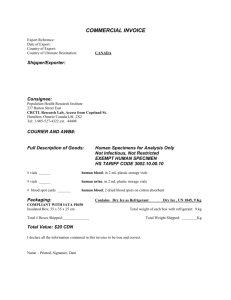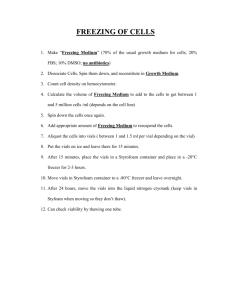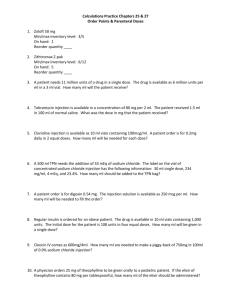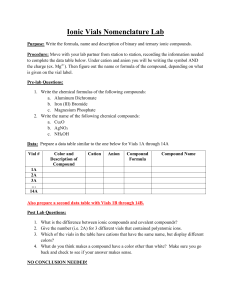MO Poison Center Antidote Chart
advertisement
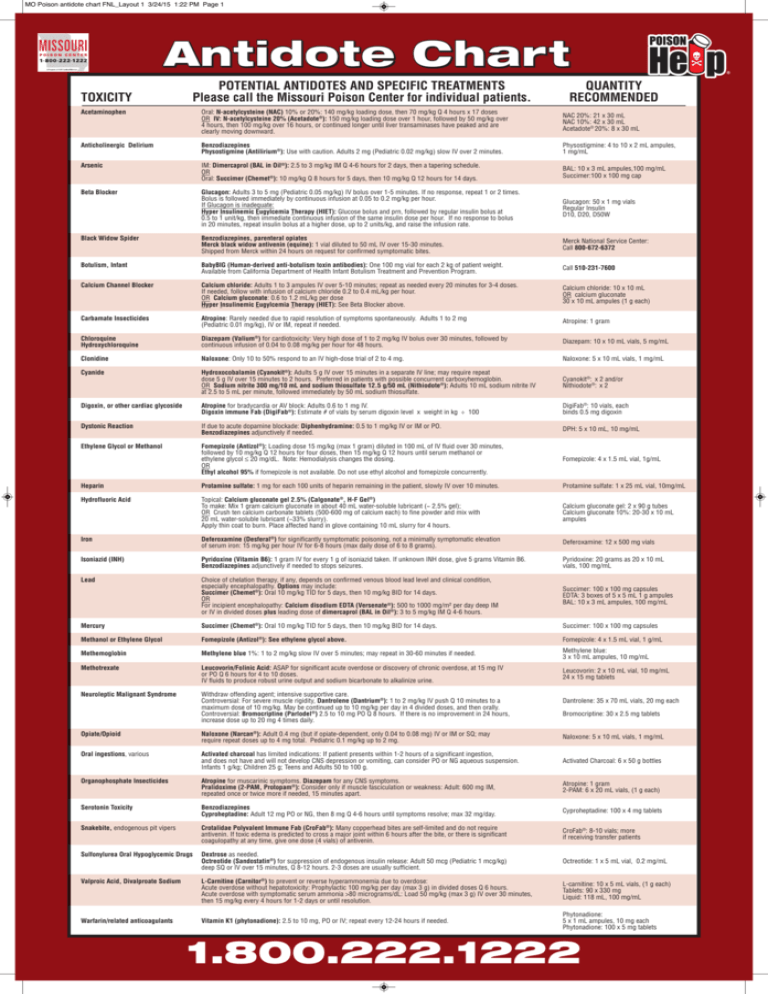
MO Poison antidote chart FNL_Layout 1 3/24/15 1:22 PM Page 1 TOXICITY POTENTIAL ANTIDOTES AND SPECIFIC TREATMENTS Please call the Missouri Poison Center for individual patients. QUANTITY RECOMMENDED Acetaminophen Oral: N-acetylcysteine (NAC) 10% or 20%: 140 mg/kg loading dose, then 70 mg/kg Q 4 hours x 17 doses OR IV: N-acetylcysteine 20% (Acetadote®): 150 mg/kg loading dose over 1 hour, followed by 50 mg/kg over 4 hours, then 100 mg/kg over 16 hours, or continued longer until liver transaminases have peaked and are clearly moving downward. NAC 20%: 21 x 30 mL NAC 10%: 42 x 30 mL Acetadote® 20%: 8 x 30 mL Anticholinergic Delirium Benzodiazepines Physostigmine (Antilirium®): Use with caution. Adults 2 mg (Pediatric 0.02 mg/kg) slow IV over 2 minutes. Physostigmine: 4 to 10 x 2 mL ampules, 1 mg/mL Arsenic IM: Dimercaprol (BAL in Oil®): 2.5 to 3 mg/kg IM Q 4-6 hours for 2 days, then a tapering schedule. OR Oral: Succimer (Chemet®): 10 mg/kg Q 8 hours for 5 days, then 10 mg/kg Q 12 hours for 14 days. BAL: 10 x 3 mL ampules,100 mg/mL Succimer:100 x 100 mg cap Beta Blocker Glucagon: Adults 3 to 5 mg (Pediatric 0.05 mg/kg) IV bolus over 1-5 minutes. If no response, repeat 1 or 2 times. Bolus is followed immediately by continuous infusion at 0.05 to 0.2 mg/kg per hour. If Glucagon is inadequate: Hyper Insulinemic Eugylcemia Therapy (HIET): Glucose bolus and prn, followed by regular insulin bolus at 0.5 to 1 unit/kg, then immediate continuous infusion of the same insulin dose per hour. If no response to bolus in 20 minutes, repeat insulin bolus at a higher dose, up to 2 units/kg, and raise the infusion rate. Glucagon: 50 x 1 mg vials Regular Insulin D10, D20, D50W Black Widow Spider Benzodiazepines, parenteral opiates Merck black widow antivenin (equine): 1 vial diluted to 50 mL IV over 15-30 minutes. Shipped from Merck within 24 hours on request for confirmed symptomatic bites. Merck National Service Center: Call 800-672-6372 Botulism, Infant BabyBIG (Human-derived anti-botulism toxin antibodies): One 100 mg vial for each 2 kg of patient weight. Available from California Department of Health Infant Botulism Treatment and Prevention Program. Call 510-231-7600 Calcium Channel Blocker Calcium chloride: Adults 1 to 3 ampules IV over 5-10 minutes; repeat as needed every 20 minutes for 3-4 doses. If needed, follow with infusion of calcium chloride 0.2 to 0.4 mL/kg per hour. OR Calcium gluconate: 0.6 to 1.2 mL/kg per dose Hyper Insulinemic Eugylcemia Therapy (HIET): See Beta Blocker above. Calcium chloride: 10 x 10 mL OR calcium gluconate 30 x 10 mL ampules (1 g each) Carbamate Insecticides Atropine: Rarely needed due to rapid resolution of symptoms spontaneously. Adults 1 to 2 mg (Pediatric 0.01 mg/kg), IV or IM, repeat if needed. Atropine: 1 gram Chloroquine Hydroxychloroquine Diazepam (Valium®) for cardiotoxicity: Very high dose of 1 to 2 mg/kg IV bolus over 30 minutes, followed by continuous infusion of 0.04 to 0.08 mg/kg per hour for 48 hours. Diazepam: 10 x 10 mL vials, 5 mg/mL Clonidine Naloxone: Only 10 to 50% respond to an IV high-dose trial of 2 to 4 mg. Naloxone: 5 x 10 mL vials, 1 mg/mL Cyanide Hydroxocobalamin (Cyanokit®): Adults 5 g IV over 15 minutes in a separate IV line; may require repeat dose 5 g IV over 15 minutes to 2 hours. Preferred in patients with possible concurrent carboxyhemoglobin. OR Sodium nitrite 300 mg/10 mL and sodium thiosulfate 12.5 g/50 mL (Nithiodote®): Adults 10 mL sodium nitrite IV at 2.5 to 5 mL per minute, followed immediately by 50 mL sodium thiosulfate. Cyanokit®: x 2 and/or Nithiodote®: x 2 Digoxin, or other cardiac glycoside Atropine for bradycardia or AV block: Adults 0.6 to 1 mg IV. Digoxin immune Fab (DigiFab®): Estimate # of vials by serum digoxin level x weight in kg ÷ 100 DigiFab®: 10 vials, each binds 0.5 mg digoxin Dystonic Reaction If due to acute dopamine blockade: Diphenhydramine: 0.5 to 1 mg/kg IV or IM or PO. Benzodiazepines adjunctively if needed. DPH: 5 x 10 mL, 10 mg/mL Ethylene Glycol or Methanol Fomepizole (Antizol®): Loading dose 15 mg/kg (max 1 gram) diluted in 100 mL of IV fluid over 30 minutes, followed by 10 mg/kg Q 12 hours for four doses, then 15 mg/kg Q 12 hours until serum methanol or ethylene glycol ≤ 20 mg/dL. Note: Hemodialysis changes the dosing. OR Ethyl alcohol 95% if fomepizole is not available. Do not use ethyl alcohol and fomepizole concurrently. Fomepizole: 4 x 1.5 mL vial, 1g/mL Heparin Protamine sulfate: 1 mg for each 100 units of heparin remaining in the patient, slowly IV over 10 minutes. Protamine sulfate: 1 x 25 mL vial, 10mg/mL Hydrofluoric Acid Topical: Calcium gluconate gel 2.5% (Calgonate®, H-F Gel®) To make: Mix 1 gram calcium gluconate in about 40 mL water-soluble lubricant (~ 2.5% gel); OR Crush ten calcium carbonate tablets (500-600 mg of calcium each) to fine powder and mix with 20 mL water-soluble lubricant (~33% slurry). Apply thin coat to burn. Place affected hand in glove containing 10 mL slurry for 4 hours. Calcium gluconate gel: 2 x 90 g tubes Calcium gluconate 10%: 20-30 x 10 mL ampules Iron Deferoxamine (Desferal®) for significantly symptomatic poisoning, not a minimally symptomatic elevation of serum iron: 15 mg/kg per hour IV for 6-8 hours (max daily dose of 6 to 8 grams). Deferoxamine: 12 x 500 mg vials Isoniazid (INH) Pyridoxine (Vitamin B6): 1 gram IV for every 1 g of isoniazid taken. If unknown INH dose, give 5 grams Vitamin B6. Benzodiazepines adjunctively if needed to stops seizures. Pyridoxine: 20 grams as 20 x 10 mL vials, 100 mg/mL Lead Choice of chelation therapy, if any, depends on confirmed venous blood lead level and clinical condition, especially encephalopathy. Options may include: Succimer (Chemet®): Oral 10 mg/kg TID for 5 days, then 10 mg/kg BID for 14 days. OR For incipient encephalopathy: Calcium disodium EDTA (Versenate®): 500 to 1000 mg/m² per day deep IM or IV in divided doses plus leading dose of dimercaprol (BAL in Oil®): 3 to 5 mg/kg IM Q 4-6 hours. Succimer: 100 x 100 mg capsules EDTA: 3 boxes of 5 x 5 mL 1 g ampules BAL: 10 x 3 mL ampules, 100 mg/mL Mercury Succimer (Chemet®): Oral 10 mg/kg TID for 5 days, then 10 mg/kg BID for 14 days. Succimer: 100 x 100 mg capsules Methanol or Ethylene Glycol Fomepizole (Antizol®): See ethylene glycol above. Fomepizole: 4 x 1.5 mL vial, 1 g/mL Methemoglobin Methylene blue 1%: 1 to 2 mg/kg slow IV over 5 minutes; may repeat in 30-60 minutes if needed. Methylene blue: 3 x 10 mL ampules, 10 mg/mL Methotrexate Leucovorin/Folinic Acid: ASAP for significant acute overdose or discovery of chronic overdose, at 15 mg IV or PO Q 6 hours for 4 to 10 doses. IV fluids to produce robust urine output and sodium bicarbonate to alkalinize urine. Leucovorin: 2 x 10 mL vial, 10 mg/mL 24 x 15 mg tablets Neuroleptic Malignant Syndrome Withdraw offending agent; intensive supportive care. Controversial: For severe muscle rigidity, Dantrolene (Dantrium®): 1 to 2 mg/kg IV push Q 10 minutes to a maximum dose of 10 mg/kg. May be continued up to 10 mg/kg per day in 4 divided doses, and then orally. Controversial: Bromocriptine (Parlodel®) 2.5 to 10 mg PO Q 8 hours. If there is no improvement in 24 hours, increase dose up to 20 mg 4 times daily. Dantrolene: 35 x 70 mL vials, 20 mg each Bromocriptine: 30 x 2.5 mg tablets Opiate/Opioid Naloxone (Narcan®): Adult 0.4 mg (but if opiate-dependent, only 0.04 to 0.08 mg) IV or IM or SQ; may require repeat doses up to 4 mg total. Pediatric 0.1 mg/kg up to 2 mg. Naloxone: 5 x 10 mL vials, 1 mg/mL Oral ingestions, various Activated charcoal has limited indications: If patient presents within 1-2 hours of a significant ingestion, and does not have and will not develop CNS depression or vomiting, can consider PO or NG aqueous suspension. Infants 1 g/kg; Children 25 g; Teens and Adults 50 to 100 g. Activated Charcoal: 6 x 50 g bottles Organophosphate Insecticides Atropine for muscarinic symptoms. Diazepam for any CNS symptoms. Pralidoxime (2-PAM, Protopam®): Consider only if muscle fasciculation or weakness: Adult: 600 mg IM, repeated once or twice more if needed, 15 minutes apart. Atropine: 1 gram 2-PAM: 6 x 20 mL vials, (1 g each) Serotonin Toxicity Benzodiazepines Cyproheptadine: Adult 12 mg PO or NG, then 8 mg Q 4-6 hours until symptoms resolve; max 32 mg/day. Cyproheptadine: 100 x 4 mg tablets Snakebite, endogenous pit vipers Crotalidae Polyvalent Immune Fab (CroFab®): Many copperhead bites are self-limited and do not require antivenin. If toxic edema is predicted to cross a major joint within 6 hours after the bite, or there is significant coagulopathy at any time, give one dose (4 vials) of antivenin. CroFab®: 8-10 vials; more if receiving transfer patients Sulfonylurea Oral Hypoglycemic Drugs Dextrose as needed. Octreotide (Sandostatin®) for suppression of endogenous insulin release: Adult 50 mcg (Pediatric 1 mcg/kg) deep SQ or IV over 15 minutes, Q 8-12 hours. 2-3 doses are usually sufficient. Octreotide: 1 x 5 mL vial, 0.2 mg/mL Valproic Acid, Divalproate Sodium L-Carnitine (Carnitor®) to prevent or reverse hyperammonemia due to overdose: Acute overdose without hepatotoxicity: Prophylactic 100 mg/kg per day (max 3 g) in divided doses Q 6 hours. Acute overdose with symptomatic serum ammonia >80 micrograms/dL: Load 50 mg/kg (max 3 g) IV over 30 minutes, then 15 mg/kg every 4 hours for 1-2 days or until resolution. L-carnitine: 10 x 5 mL vials, (1 g each) Tablets: 90 x 330 mg Liquid: 118 mL, 100 mg/mL Warfarin/related anticoagulants Vitamin K1 (phytonadione): 2.5 to 10 mg, PO or IV; repeat every 12-24 hours if needed. Phytonadione: 5 x 1 mL ampules, 10 mg each Phytonadione: 100 x 5 mg tablets 1.800.222.1222



